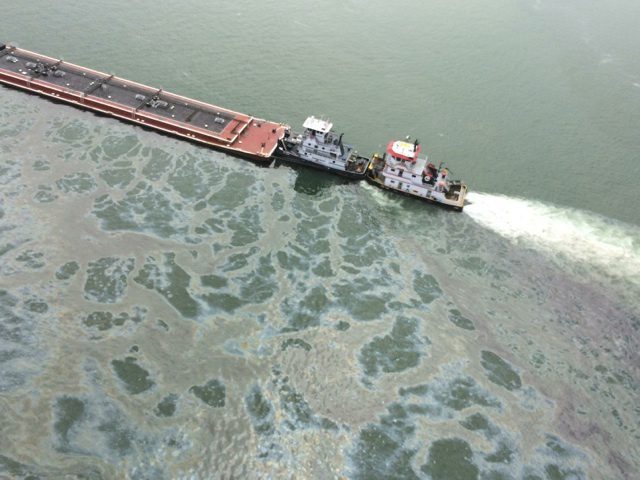A tank barge leaks fuel oil following a collision with a bulk carrier, March 22, 2014 in the Houston Ship Channel. U.S. Coast Guard Photo
[contextly_sidebar id=”Jr4hoLuDio0M4HU4Bb5arELj8pMW7XCi”]
A U.S. National Transportation Safety Board investigation into the March 2014 collision between a towing vessel with two barges and a bulk carrier on the Houston Ship Channel has determined that the towing vessel’s Captain attempted to cross the Channel ahead of the bulk carrier, impeding the passage of the vessel.
At about 1235 CDT on March 22, 2014, the 607-foot-long bulk carrier Summer Wind with a Houston pilot on board collided with the 670-foot-long Miss Susan – a 70-foot-long shallow draft towing vessel and two 300-foot-long tank barges loaded with fuel oil – in the Houston Ship Channel, Lower Galveston Bay, Texas. Visibility was restricted at the time due to fog. The bulk carrier was inbound to Houston, traveling in a north direction. The tow was bound for Port Bolivar on the east side of the Houston Ship Channel, traveling in an east direction.
The NTSB determined that the vessels collided because the towing vessel crossed the Houston Ship Channel, impeding the passage of the bulk carrier that was transiting inbound, which could only transit within the channel.
The collision resulted in the release of 168,000 gallons of fuel into the Houston Ship Channel from the breach of the forward barge and the hospitalization of two crewmembers on the Miss Susan for inhalation-related injuries. As a result, the NTSB recommended that crews on vessels transporting hazardous materials receive appropriate training, personal protective gear, and access to direct-reading air monitoring equipment.
Prior to the accident, visibility in the Houston Ship Channel was restricted and nearby there was towing vessel traffic.
Contributing to the accident was the failure of the Summer Wind’s master and the Houston pilot on board the Summer Wind to set a safe speed or discuss the tow traffic in the waterway. Also, the captain on the Miss Susan and the Houston pilot failed to establish early radio communication as they transited through Bolivar Roads Precautionary Area, a high traffic area which includes several intersecting waterways and requires vessels to navigate with caution.
At the time of the accident, the Summer Wind, which was traveling at a full speed of 12 knots, had little room to maneuver. The margin of safety would have increased with a slower transit speed. However, according to navigation rules, the Miss Susan should not have crossed the main channel ahead of the Summer Wind.
Following its investigation, the NTSB reclassified a recommendation to the U.S. Coast Guard from “Open?Acceptable Response” to “Open?Unacceptable Response,” and also reiterated the need to develop and implement a policy to ensure adequate separation of vessels in the precautionary areas in the Houston Ship Channel. The report also reiterates a recommendation to graphically delineate precautionary areas on appropriate Houston Ship Channel nautical charts so they are readily identifiable to mariners.
The report also notes that leading up to the accident, the U.S. Coast Guard Vessel Traffic Service staff was monitoring several radio channels simultaneously. The watch standers missed the radio communications about the developing close quarter’s situation.
“A safe transit through congested waterways requires a team effort,” commented NTSB Chairman Christopher A. Hart.
The full report including findings, the probable cause, and all recommendations can be found HERE.

 Join The Club
Join The Club











